1. Avoid paid keyword traps.
Sharing keyword intelligence is a standard best practice. Sometimes, certain types of keywords can have subtle differences, and end up aligning to the wrong intent. It's important to understand the intent behind search terms, because you want to avoid keyword traps.
SEO-focused marketers are the masters of understanding search intent, and therefore collaboration between SEO and SEM is critical.
For example, the restaurant POS software, Toast, is bidding on "phone systems for restaurants" but they don't sell phone systems! They're broad match bidding on terms containing "restaurant."
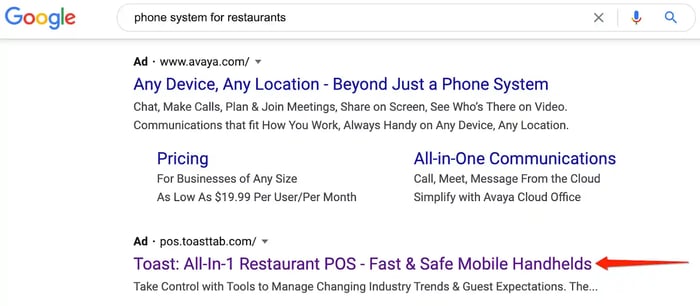
This is why Google has become a modern day casino for advertisers. The marketing team at Toast is gambling on the mere possibility that restaurant managers seeking a phone system might also be in the market for POS software.
While it might work, the potential for bleeding is likely. That said, Toast is venture-backed and valued at $4.9B, so this is probably a gamble they're comfortable taking.
You need to study the search results closely if you want to master the art of understanding keyword intent. Google often signals their own interpretation of a search term, based on the types of results.
For example, if you Google "sales funnel" the search engine results page (SERP) indicates you're looking for the definition of a sales funnel.
The results are largely definition style SEO pages, and therefore it's obvious that a product page wouldn't rank for this query.
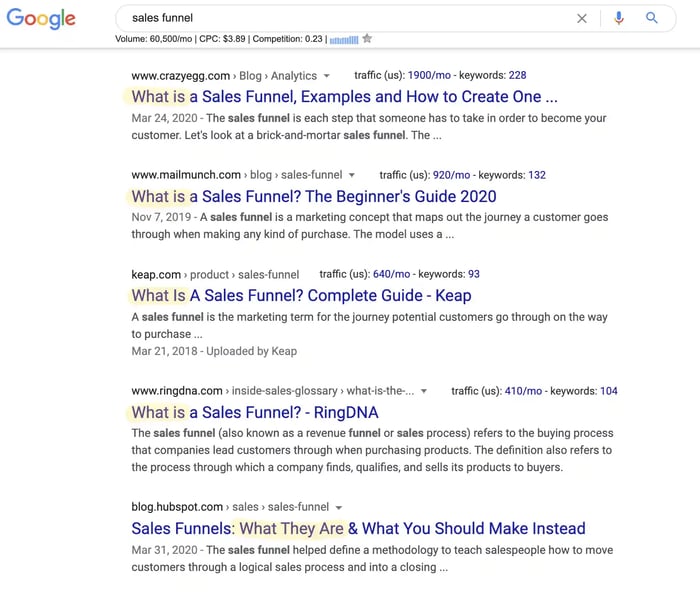
Let's examine another example of a keyword trap. If you perform a Google search for "online training" you're going to see two vastly different results in the ads.
- Cisco - Virtual Classroom Solutions
- Udemy - Best Selling Online Courses
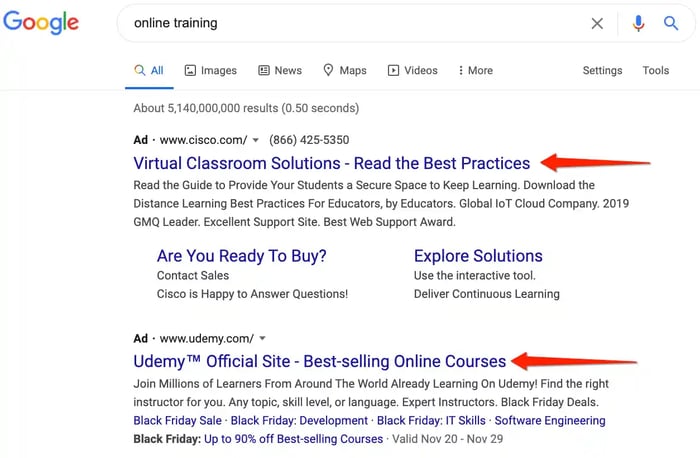
These are two wildly different search intents. How do you know if a searcher wants online training software versus online courses? There's no way to be 100% certain.
However, the organic results are overwhelmingly online course companies such as Udemy, Lynda, and Coursera. The people alsoask box is hinting at the search intent, because most of the questions are about online training.

Based on what the organic listings are showing, I would conclude that Cisco's ad is largely irrelevant. They might get lucky and grab some clicks, but they're probably losing money on this ad set.
Now, the question becomes, do they care? Probably not. After all, they're a $180B market cap, which means Cisco can afford to continue making Google rich.

What about the small guys? This is where SMBs have a tremendous disadvantage, and can't afford to bleed on paid ads like the behemoths. For that reason, I would recommend startups prioritize SEO efforts in order to avoid the royal rumble of paid ads with giant companies like Cisco.
Let's also examine "sms marketing examples" where Mobile Monkey nails the search intent with this page, and gets rewarded with the organic featured snippet. Meanwhile, advertisers are off the mark.
- Vonage - hoping that a subset of searchers might be interested in APIs for SMS.
- Remarkety - hoping that a subset of searchers might be interested in SMS marketing solutions.

What's the bottom line?
SEOs will habitually review SERP signals to make sure the content they publish matches with Google's organic search results, and ultimately delivers a high degree of satisfaction with regard to searcher task accomplishment.
Is your content helping searchers accomplish the task they need to complete?
This is particularly useful when there are potential keyword traps — words and phrases that sound good, but have dual meanings or a mismatched intent.
If potential dual meanings exist in your industry, SEOs will catch them. All that's left to do is to get them to share their insights with your PPC team.
2. Share PPC insights on best performing headlines and descriptions.
When your SEO team decides to pursue a new keyword, it can be months before they see measurable results. If it was the right keyword and phrase to target, that's success.
But if click-through rate (CTR) and engagement is low — even if it ranks on page one — you've now spent your time and budget running circles in an SEO hamster wheel. And, by the way, CTR is an indirect SEO ranking factor.
SEM is the exact opposite. You'll know whether or not PPC ad copy is working — usually within a matter of days with low investment. So you might consider using PPC to get fast, short-term results, and use those insights to fuel your larger SEO strategy.
Test as many ad copy variations as possible, until you have the data that will support your SEO campaigns.
Here are some things you can test:
- Headlines, title tags, and description copy.
- Keywords and topics.
- Specific keyword angles.
- Landing page variations.
- New product messaging.
PPC campaign results will reveal each headline's impact on clicks, time on page, bounce rate, goal completions, and other meaningful engagement signals. If you run longer tests, you can also learn how a specific keyword's demand fluctuates from month to month, which will help you set more accurate expectations with your SEO team.
Use PPC insights to choose the best topics, write and optimize your headlines and meta descriptions, and align to your audience's needs and expectations.
3. Optimize your landing pages to reap both SEO and PPC benefits.
Spending money on paid ads without running efficient landing page tests could result in tons of wasted money and effort.
The benefits of optimizing your landing pages are fairly obvious: you don't burn precious marketing dollars on ineffective content experiences.
If you're looking for more in-depth specifics on creating landing pages that convert, I would recommend checking out 19 of the Best Landing Page Design Examples You Need to See in 2020.
Ultimately, SEO & PPC teams must align their most valuable assets — landing pages.
3 important actions need to happen:
- You have a noindexed, conversion focused landing page built for PPC advertising. Your main goal conversions are going to be form completions, demo requests, live chat inquiries, etc.
- You are working with the SEO and CRO teams to build new landing page variants with intelligent hypotheses. Your goal is to split test these pages and monitor the results.
- You are working with the SEO team to create a separate asset, which is longer-form and educational, on the same topic for which you want to drive organic visibility.
Ultimately, marketers should craft a surround sound search engine marketing strategy.
Say, for example, a shopper searches for your brand or product name, clicks on your PPC ad, stays for a minute, and then exits the page.
Days later, they search for guides to help them choose a solution, which leads them to an educational piece of content you produced on that same topic.
As they click around, browse, and scroll through the online listings, your brand is on their radar. They get used to your tone, visuals, and messaging. If they liked what they saw through your PPC ads, they'll look for your name in a sea of organic listings the next time — and vice versa.
In brand marketing, what gets repeated gets remembered, and what gets remembered, gets done.
SEO expert, Rand Fishkin, wrote about the ludicrously powerful influence of brand repetition in his 2020 election recap article:
"Hear a song over and over, and even if you hate it, your brain will subconsciously hum it. Hear a brand name over and over and you'll assume the company behind it must be a big, important, and probably trustworthy one."
4. Work together to achieve SERP domination.
Taking up the first organic spot for your target keyword is not enough anymore. There's so much noise and clutter in Google's result pages, that you need to occupy as much digital real estate as possible.
Udemy has clearly figured this out. Check out their ad + organic listing, flying high together for the SERP targeting "excel courses."
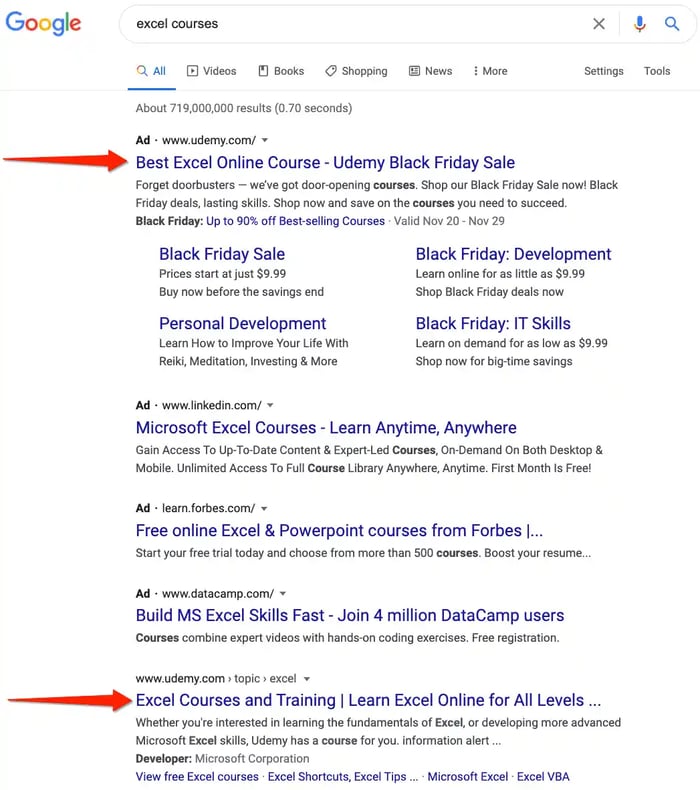
Check out GetVoIP's SEO + PPC combo strategy for an insanely competitive SERP. They've got a killer landing page targeting "Business VoIP" and it's soaking up both organic and paid traffic. This particular SERP is a double whammy for GetVoIP, because they've also got the precious featured snippet.
You can also see Nextiva ranking organically below GetVoIP. Since Nextiva is mentioned positively and has excellent reviews on GetVoIP's listing page, this is a strategic chess move which is part of the surround sound search marketing playbook, coined by Irina Nica from HubSpot.
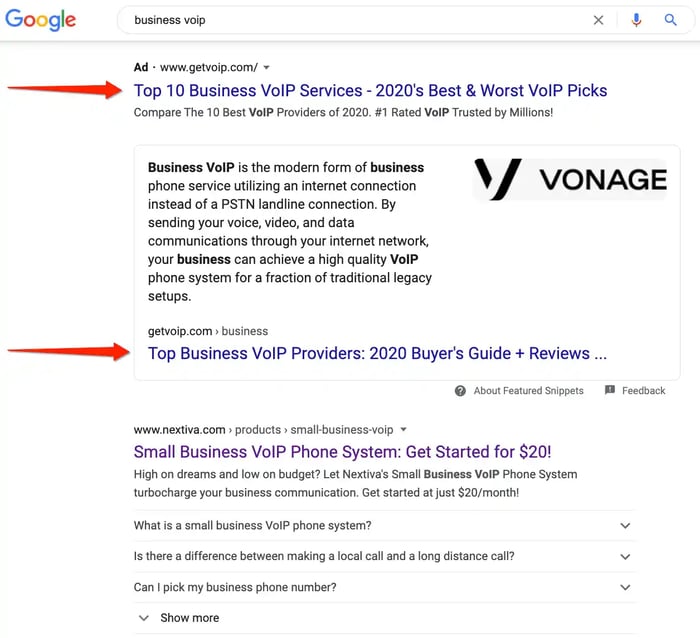
The list of SERP features that could push your organic success down the page is endless, including:
- Rich snippets.
- Google shopping results.
- Knowledge cards.
- People also ask.
- Video carousels.
- Image packs.
- Localized results.
It can leave your SEO team feeling deflated, doing all that grueling work to earn a #1 organic ranking just to be thwarted by Google's UX schemes.
The reality is that Google is extorting companies for playing brand defense. (Bing is just as guilty).
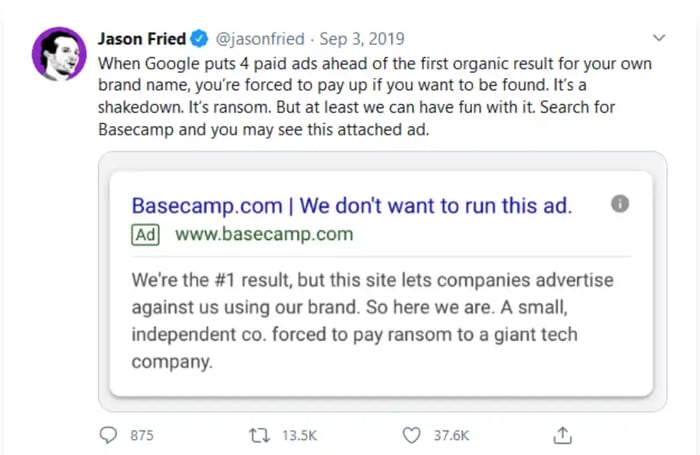
While this is a challenge for some marketers, don't hate the player — hate the game. You can still fight back with smart collaboration between SEO, PPC, and affiliate partners.
Apart from Google's questionable ethics, you should still continue to bid against the high value search terms you're already ranking for, in order to achieve what's known as SERP domination.
Here's how the productivity platform ClickUp achieves this.
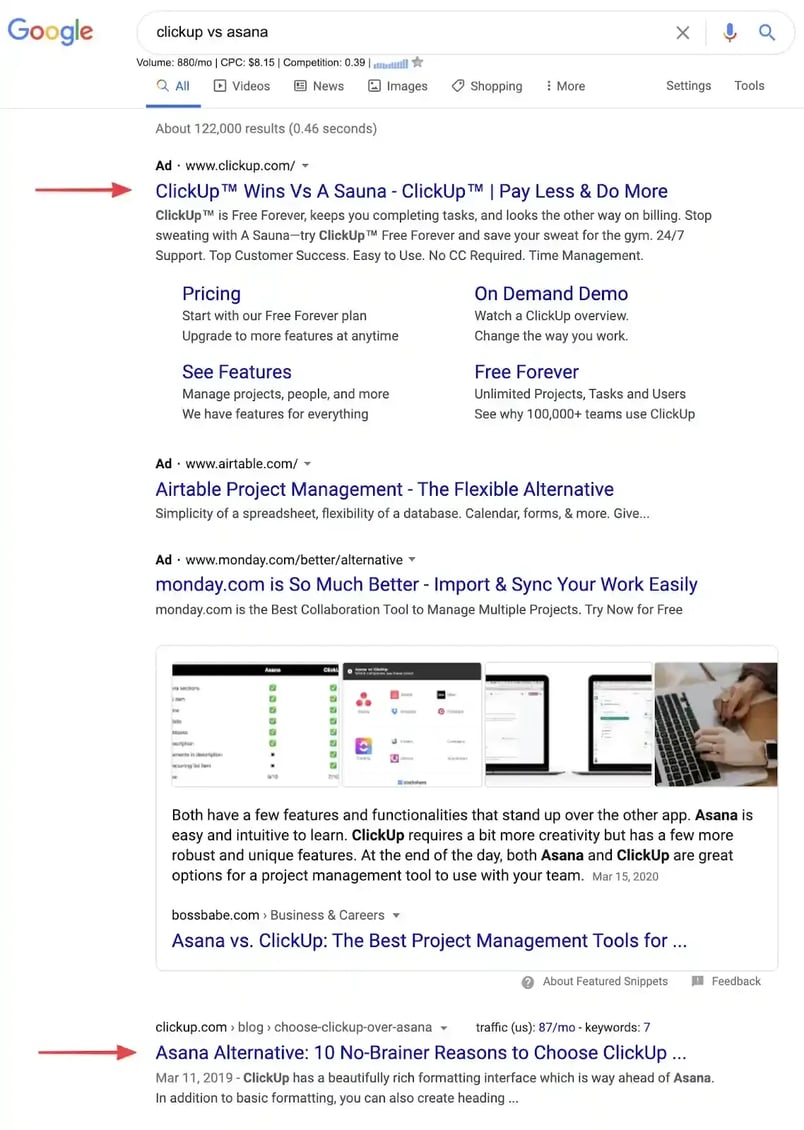
Out of the top five results we can see above the fold, ClickUp took up two. The paid result takes you to a product page, while the organic result is a blog post — both super specific to the search term.
To implement this, analyze your SEO performance to find your highest-ranking pieces and run paid ads against those keywords. This will unlock SERP domination for your most valuable keywords.
5. Reveal "hidden keywords" within the buyer journey.
It's unrealistic to expect every keyword, blog post, landing page, and paid search ad to convert visitors into leads. In fact, I've talked about this extensively with Chris Walker on the state of demand generation podcast — stop creating content purely for lead generation, and instead focus on educating a niche audience.
All roads lead back to user intent. Your keyword research needs to focus on the searcher's ultimate goal and be broken down into three main intent buckets: transaction vs. research vs. education.
Here's how we've mapped out the customer journey at Nextiva within the context of marketing our commercial phone service offering. Each stage of the buying process has a distinct emotion tied to it.
- Unaware: Not aware I have a problem → I've never actually considered we may have a problem communicating with our customers, prospects and partners.
- Problem aware: I think I have a problem but I'm not doing anything about it yet → I think we're having issues communicating with our customers, prospects and partners, but I haven't started searching for a solution yet.
- Solution Aware: I'm actively searching for a solution → I've finally realized we have a problem communicating with our customers, prospects and partners, so I'm searching for a solution online.
- Product aware: I've found a few solutions, including yours → I've seen your solution, but I'm not entirely convinced you're the right one for me.
- Most aware: I've chosen your product and I'm ready to commit → Show me the buy button.
This concept is nothing new. HubSpot pioneered the buyer's journey in B2B before it was a big thing.
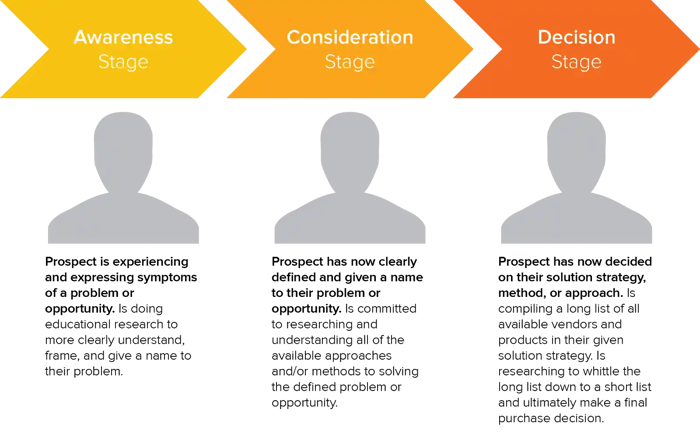
Based on the buying process, you should bucket your keywords for SEO and PPC campaigns into:
- Educational: Guide, tutorial, resource, questions like 'how,' 'what,' and 'why,' examples, tips.
- Solution: Best, reviews, integrations, comparison, top.
- Transactional: Demo, free trial, buy, pricing.
Advertisers should avoid bidding on education keywords, and focus on solution + transactional.
The following graphic is a brilliant resource from Mike Sonders, outlining the highest demand keywords for SaaS consideration stage content:
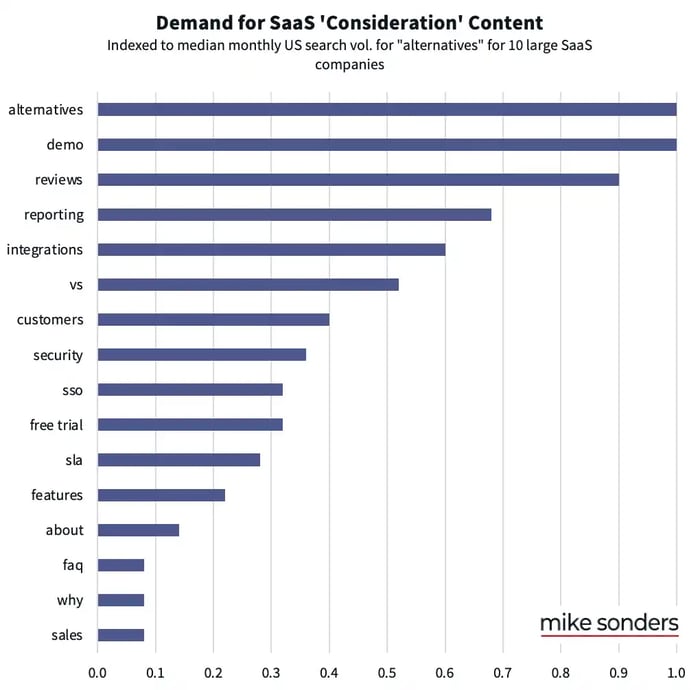
At this point, you should align with your PPC team on the following:
- Which keywords have tolerable CPC (cost per click) + high conversion rates?
- Which keywords have the best cost per acquisition?
- Which keywords are the most profitable?
- Which keywords actually generate meaningful pipeline value?
- Which keywords have the best sales close rates?
- Which keywords drive the longest LTV customers?
At this crossroad is where the greatest SEO and PPC magic typically happens.
6. Use audience insights to test and clarify messaging.
I mentioned the value of instant results that come with PPC campaigns compared to SEO. Another key benefit of PPC is testing ads against various demographics and interests.
You can analyze specifics such as:
- Age groups
- Gender
- Household income
- Locations
- Devices
- Interests and lifestyle
We once tested some aspirational messaging on Nextiva's homepage. And I'll be honest, it bombed.
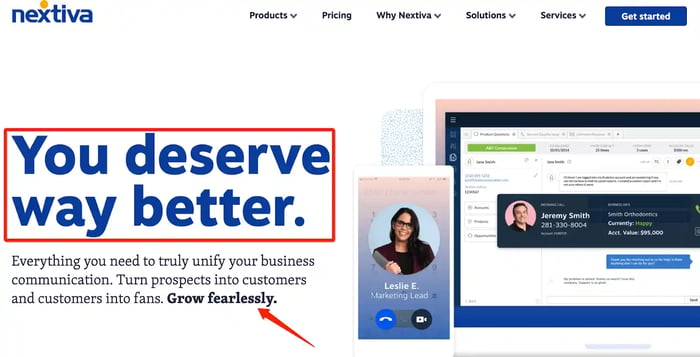
At least we were able to course correct quickly, thanks to the speediness of learning via paid ads.
The greatest benefit of audience targeting is that you can test brand and product-specific messages against various demographics and interest groups. Some companies claim they've mastered the art of personalization based on the website traffic segment visiting the page, but I have yet to see one company do this excellently.
Pro tip: Look at the search terms report in your Google Ads platform (formerly Google AdWords) to find those long-tail gold mines. These are the search terms that are actually generating clicks from your broad and phrase match campaigns.
With this unique wealth of knowledge, you'll be able to better inform your SEO strategy by unlocking hidden long-tail opportunities, aligned to your different target audience segments.
7. Apply PPC conversion data to your SEO strategy.
The benefit of search engine optimization is that the longer you do it, the more actionable your data becomes. At Nextiva, our SEO strategy is aligned closely to our PPC campaigns, therefore allowing us to grow organic traffic in a meaningful way, rather than vanity driven top-of-funnel visibility.

We've followed HubSpot's classic pillar clustering model to rank for outrageously competitive head terms like VoIP (mind blowing 80,000 monthly searches), supported by adjacent longer tail content all cross-linked together.
Not only is this a brilliant internal linking mechanism, but it helps your website build authority and topical depth. Eventually, Google starts to closely associate your brand with important concepts and entities. This is how you evolve past SEO 101 and unlock SEO mastery.
Ranking for an 80,000 monthly search volume keyword is pretty damn sweet. But it's even better when you're at position zero with a glorious featured snippet.

Why did Nextiva focus on ranking for VoIP? Because our PPC data told us it drives larger line size opportunities. That's the beauty of SEO & PPC alignment — uncovering those precious hidden insights.
Your PPC team operates like a stock broker, optimizing for the highest return on investment. This means that their marketing campaign reports tell them which keywords:
- Convince the most visitors to become subscribers and leads.
- Generate the most engagement.
- Lead to most purchases.
- Are the most profitable.
Believe it or not, most SaaS companies are not running profitable Google Ads campaigns. There are many reasons why this happens. I've spoken extensively about this with Chris Walker on the State of Demand Generation podcast.
What's the bottom line?
PPC conversion data is powerful. When you match these keywords to your SEO goals, you can focus your organic SEO efforts on keywords that will make the biggest difference to your organic search traffic — including brand awareness, engagement, and net-new customer acquisition.
SEO + PPC = Search Marketing Glory
When you break down your SEO and PPC silos, you'll unlock a world of opportunities. Use this list and start uniting your SEO and PPC teams without getting overwhelmed.
It's not about SEO vs. PPC anymore — it's about crafting a holistic approach to search marketing, increasing your competitive advantage across your best performing channels, and reaching your target customers exactly when (and how) they are looking for you.
SEO Strategy





![How to Create an SEO Strategy [Template Included]](https://53.fs1.hubspotusercontent-na1.net/hubfs/53/SEO-Strategy.png)

![Should Marketers Optimize for Bing? [Data + Expert Tips]](https://53.fs1.hubspotusercontent-na1.net/hubfs/53/BING-SEO%20(1).png)


![How Web Strategists Think SGE Could Impact Search Pages [New Data]](https://53.fs1.hubspotusercontent-na1.net/hubfs/53/Copy%20of%20Featured%20Image%20Template%20Backgrounds%20(5)-1.png)
![How to Find SERP Feature Opportunities [+ Free Tools]](https://53.fs1.hubspotusercontent-na1.net/hubfs/53/serp-feature-opportunities.jpg)
